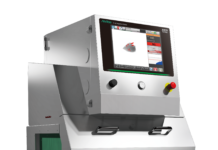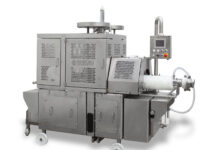 The measurement of fat, protein, water and collagen is a crucial criterion to determine the quality of meat intended for direct consume or specific processing. As regards to the fat content, some meat preparations (sausages and salami, hamburger, etc.) require to add a pre-determined amount of fat or some cuts of meat with a certain percentage of fat are combined together; therefore knowing the exact quantity of fat already present in meat has significant implications to achieve a good end product as well as a satisfactory economic result. Often the percentage of fat in some anatomical cuts of meat or the preparation of some meat becomes part of the contractual specifications between commercial partners, and if this is not respected, it can lead to financial jurisdiction or refusal to buy the product. The indication of the quantity of fat and protein is part of the food labeling protocol, whose instructions have become compulsory since the recent EU Regulations 1169/2011 in the labeling of food products. The water content has also become a very important aspect, especially for the preparation of some meat (for example, cooked ham) where water is added during the preparation process, in quantities often determined by law (with a label reporting the percentage of meat in the product) and/or by commercial agreements. Finally, the collagen content can also have a very important impact on meat products: it’s a protein less valuable than the others that form the muscle, as it derives from connective tissues (tendon, cartilage, ligaments, skin, etc.) and it’s added in some food preparations due to its cheap price. An excessive amount of these components can have negative effects on the aspect and the texture of the final product, such as gelatinous areas or hard lumps that can be experienced while chewing. The classic chemical-analytical methods used to determine such measurements are rather long, difficult and expensive: for example, Soxhlet extraction to determine the fat content, Kjeldahl method to determine the protein content, Karl fisher method to determine the water content as well as the hydroxyproline content to indirectly determine the collagen measurement. These methods cannot be easily applied to daily routine in the meat processing industry (in particular if considering that in some cases for example, if different meats are combined together for a certain end product, the measurements will need to be repeated at various times during the production process). There are techniques that are capable to calculate all these measurements (fat, protein, water and collagen) in an economic, quick and accurate way without requiring frequent calibrations. Among these, the NIR (near-infrared) spectroscopy is well known. This spectroscopic and absorption technique is used in many different scientific fields. When an infrared photon (typically with wavelength between 1000 to 2500 nm) is absorbed by a molecule, the molecule transforms from its ground state to an excited state releasing a visible signal on the IR. The NIR method is used in many applications in the food production field, including the meat sector. A portion of meat can be directly selected during the production process, homogenized and analyzed with the NIR technique in a few seconds, monitoring the production process instantaneously and making changes whether necessary to the product: this allows creating batches of products with characteristics that can be reproduced and therefore reducing the risk of non-conformities and commercial problems.
The measurement of fat, protein, water and collagen is a crucial criterion to determine the quality of meat intended for direct consume or specific processing. As regards to the fat content, some meat preparations (sausages and salami, hamburger, etc.) require to add a pre-determined amount of fat or some cuts of meat with a certain percentage of fat are combined together; therefore knowing the exact quantity of fat already present in meat has significant implications to achieve a good end product as well as a satisfactory economic result. Often the percentage of fat in some anatomical cuts of meat or the preparation of some meat becomes part of the contractual specifications between commercial partners, and if this is not respected, it can lead to financial jurisdiction or refusal to buy the product. The indication of the quantity of fat and protein is part of the food labeling protocol, whose instructions have become compulsory since the recent EU Regulations 1169/2011 in the labeling of food products. The water content has also become a very important aspect, especially for the preparation of some meat (for example, cooked ham) where water is added during the preparation process, in quantities often determined by law (with a label reporting the percentage of meat in the product) and/or by commercial agreements. Finally, the collagen content can also have a very important impact on meat products: it’s a protein less valuable than the others that form the muscle, as it derives from connective tissues (tendon, cartilage, ligaments, skin, etc.) and it’s added in some food preparations due to its cheap price. An excessive amount of these components can have negative effects on the aspect and the texture of the final product, such as gelatinous areas or hard lumps that can be experienced while chewing. The classic chemical-analytical methods used to determine such measurements are rather long, difficult and expensive: for example, Soxhlet extraction to determine the fat content, Kjeldahl method to determine the protein content, Karl fisher method to determine the water content as well as the hydroxyproline content to indirectly determine the collagen measurement. These methods cannot be easily applied to daily routine in the meat processing industry (in particular if considering that in some cases for example, if different meats are combined together for a certain end product, the measurements will need to be repeated at various times during the production process). There are techniques that are capable to calculate all these measurements (fat, protein, water and collagen) in an economic, quick and accurate way without requiring frequent calibrations. Among these, the NIR (near-infrared) spectroscopy is well known. This spectroscopic and absorption technique is used in many different scientific fields. When an infrared photon (typically with wavelength between 1000 to 2500 nm) is absorbed by a molecule, the molecule transforms from its ground state to an excited state releasing a visible signal on the IR. The NIR method is used in many applications in the food production field, including the meat sector. A portion of meat can be directly selected during the production process, homogenized and analyzed with the NIR technique in a few seconds, monitoring the production process instantaneously and making changes whether necessary to the product: this allows creating batches of products with characteristics that can be reproduced and therefore reducing the risk of non-conformities and commercial problems.



